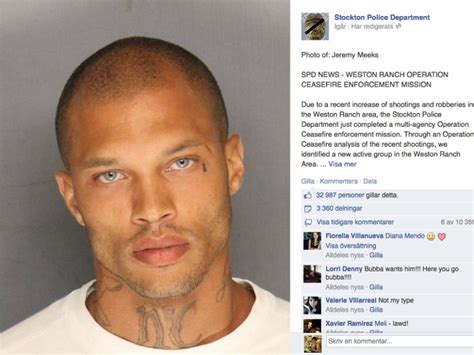
Jeremy Meeks, the former convict whose 2014 mugshot catapulted him to viral fame and earned him the moniker “Hot Felon,” has transitioned from internet sensation to a millionaire model and entrepreneur, navigating a path that includes high-fashion runways, reality television, and business ventures. While his initial notoriety stemmed from his criminal past, Meeks has since leveraged his striking looks and newfound platform to build a career in the fashion industry and explore other opportunities.
Meeks’ journey began when his mugshot, taken during an arrest for felony firearm possession, was posted on the Stockton Police Department’s Facebook page. The image quickly went viral, attracting widespread attention for his chiseled features and piercing blue eyes. Offers flooded in even while he was incarcerated, and upon his release in 2016, Meeks signed with White Cross Management.
His modeling career took off swiftly, with appearances at New York Fashion Week in 2017, walking the runway for Philipp Plein. He has since worked with numerous high-profile brands and designers, solidifying his place in the fashion world. Beyond modeling, Meeks has also ventured into acting, appearing in films such as “Trigger” (2020).
Meeks’ personal life has also been under public scrutiny. His marriage to Melissa Meeks ended in divorce after he was photographed with Chloe Green, the daughter of British businessman Sir Philip Green. He and Green had a son together, but their relationship eventually ended. Meeks is now reportedly dating Jessica Turri, and continues to reside in Los Angeles, pursuing his career and focusing on his family. His story remains a unique example of how viral fame can lead to unexpected opportunities, but it also highlights the challenges of navigating the transition from convict to celebrity.
From Prison to Podium: The Meteoric Rise of Jeremy Meeks
The narrative of Jeremy Meeks is one that epitomizes the unpredictable nature of viral fame in the digital age. His trajectory from a convicted felon to a celebrated figure in the fashion industry underscores the transformative power of social media and the evolving standards of celebrity. However, it also invites critical examination of the ethical implications of rewarding criminal behavior and the complexities of second chances.
In 2014, Meeks’ life took an unforeseen turn when his mugshot, disseminated through the Stockton Police Department’s Facebook page, ignited a global frenzy. The image, characterized by his striking blue eyes, sharp jawline, and teardrop tattoo, rapidly circulated across the internet, amassing thousands of likes, comments, and shares. The term “Hot Felon” quickly became synonymous with Meeks, as his image transcended the boundaries of law enforcement and infiltrated the realm of popular culture.
The unprecedented attention garnered by Meeks’ mugshot sparked a heated debate about the objectification of criminals and the glamorization of criminal behavior. Critics argued that the public’s fascination with Meeks’ physical appearance trivialized the severity of his offenses and perpetuated harmful stereotypes about beauty and criminality. Conversely, supporters contended that Meeks deserved a second chance and should not be defined solely by his past mistakes.
Despite the controversy surrounding his newfound fame, Meeks seized the opportunity to transform his life. Upon his release from prison in 2016, he signed with White Cross Management, a Los Angeles-based modeling agency, and embarked on a career in the fashion industry. His transition from inmate to international model was swift and remarkable, as he quickly secured lucrative contracts with high-end brands and designers.
Runway Ready: Meeks’ Foray into High Fashion
Meeks made his official runway debut at New York Fashion Week in February 2017, walking for Philipp Plein. This marked a significant turning point in his career, solidifying his credibility within the fashion world and signaling his transition from internet sensation to legitimate model. The show was a spectacle, featuring elaborate staging and a star-studded guest list, further amplifying Meeks’ visibility and cementing his status as a rising star.
“It was an incredible experience,” Meeks said in an interview following the show. “I’m so grateful for the opportunity that Philipp Plein gave me. It’s a dream come true.”
His appearance at New York Fashion Week opened doors to numerous other opportunities, including collaborations with prominent fashion houses and editorial features in leading magazines. He has since worked with brands such as Tom Ford and walked in fashion shows in Milan and Paris, establishing himself as a fixture in the international fashion scene.
Beyond the runway, Meeks has also ventured into acting, landing roles in independent films and television shows. His foray into acting demonstrates his ambition to expand his career beyond modeling and explore new creative outlets. While his acting career is still in its early stages, Meeks has expressed a strong desire to hone his skills and pursue more challenging roles in the future. “I’m really enjoying the acting process,” he said. “It’s a new challenge for me, and I’m excited to see where it takes me.”
Personal Life in the Public Eye: Relationships and Family
While Meeks’ professional life has been marked by success and transformation, his personal life has been subject to intense public scrutiny. His marriage to Melissa Meeks, his wife of eight years, ended in divorce after he was photographed kissing Chloe Green, the daughter of British retail magnate Sir Philip Green, in 2017. The scandal sparked a media frenzy, with tabloids and gossip websites dissecting the details of their relationship and the impact on Meeks’ marriage.
The divorce from Melissa Meeks was finalized in 2018, and Meeks subsequently entered into a relationship with Chloe Green. The couple welcomed a son, Jayden Meeks-Green, in May 2018. However, their relationship eventually ended, and Meeks is now reportedly dating Jessica Turri.
Despite the challenges and controversies surrounding his personal life, Meeks has remained committed to his role as a father. He frequently posts photos and videos of his children on social media, expressing his love and devotion to his family. He has also spoken openly about the importance of being a positive role model for his sons, emphasizing the need to learn from his past mistakes and make responsible choices.
Entrepreneurial Ventures and Future Aspirations
In addition to his modeling and acting career, Meeks has also explored entrepreneurial ventures, launching his own clothing line and pursuing other business opportunities. His foray into entrepreneurship reflects his ambition to build a sustainable career and diversify his income streams. While details about his specific business ventures are limited, Meeks has expressed a strong interest in investing in real estate and developing other projects that align with his personal brand.
Looking ahead, Meeks aims to continue expanding his career in the entertainment industry and building his brand as a multifaceted talent. He has expressed a desire to take on more challenging acting roles, collaborate with established designers and brands, and develop his entrepreneurial ventures. He remains focused on staying grounded and maintaining a positive outlook. “I’m just grateful for the opportunities that I’ve been given,” he said. “I’m going to keep working hard and see where it takes me.”
The Ethical Dilemma: Redemption or Reward?
The story of Jeremy Meeks raises complex ethical questions about redemption, second chances, and the glorification of criminal behavior. While some view his transformation as an inspiring example of personal growth and resilience, others argue that his success sends the wrong message and normalizes criminal behavior.
Critics argue that Meeks’ fame is a direct result of his criminal past and that he has been unfairly rewarded for his actions. They contend that his success trivializes the suffering of victims of crime and undermines the principles of justice and accountability. Furthermore, they express concern that his story may encourage others to seek fame and fortune through criminal behavior.
Conversely, supporters argue that Meeks has paid his debt to society and deserves a second chance to rebuild his life. They point to his efforts to turn his life around, his commitment to his family, and his willingness to use his platform to promote positive messages. They argue that judging him solely on his past mistakes ignores his potential for growth and his contributions to society.
The debate surrounding Jeremy Meeks highlights the tension between the desire for redemption and the need for accountability. While society should offer opportunities for rehabilitation and second chances, it must also ensure that criminal behavior is not glorified or rewarded. The challenge lies in finding a balance between these competing values and creating a system that promotes both justice and compassion.
A Modern-Day Fairytale?
Jeremy Meeks’ life story reads like a modern-day fairytale, albeit one with a complicated beginning. His rise from convicted felon to fashion icon is a testament to the power of social media, the allure of beauty, and the enduring human fascination with transformation. However, it is also a cautionary tale about the perils of instant fame, the challenges of navigating the public eye, and the importance of staying grounded in the face of success.
His journey underscores the transformative potential of the digital age, where anyone can become a celebrity overnight. However, it also highlights the superficiality of online fame and the importance of building a lasting career based on substance and skill.
Ultimately, the story of Jeremy Meeks is a reminder that life is full of unexpected twists and turns, and that the path to success is rarely linear. It is a story of redemption, transformation, and the enduring power of hope. Whether he will continue to thrive in the spotlight remains to be seen, but his journey thus far has been nothing short of extraordinary.
Frequently Asked Questions (FAQ)
1. How did Jeremy Meeks become famous?
Jeremy Meeks gained fame after his mugshot, taken during an arrest for felony firearm possession in 2014, went viral on the Stockton Police Department’s Facebook page. His striking appearance led to widespread attention and the “Hot Felon” moniker.
2. What is Jeremy Meeks doing now?
Currently, Jeremy Meeks is working as a model and entrepreneur. He has walked in fashion shows for prominent designers, appeared in films, and is reportedly pursuing various business ventures. He lives in Los Angeles and focuses on his career and family.
3. Who has Jeremy Meeks dated?
Meeks was previously married to Melissa Meeks, but they divorced after he was seen with Chloe Green. He then dated Chloe Green, with whom he had a son. He is now reportedly dating Jessica Turri.
4. When did Jeremy Meeks get out of prison?
Jeremy Meeks was released from prison in 2016. Shortly after his release, he signed with White Cross Management and began his modeling career.
5. What was Jeremy Meeks in prison for?
Jeremy Meeks was arrested and imprisoned for felony firearm possession. His mugshot was taken at the time of his arrest in 2014.
Expanded Analysis and Context
The Jeremy Meeks phenomenon offers a unique lens through which to examine several cultural and societal trends. His story touches on the objectification of beauty, the power of social media, the complexities of criminal justice, and the allure of celebrity culture. To fully understand his trajectory, it is essential to delve deeper into these interconnected themes.
The Objectification of Beauty and the Power of the Image:
Meeks’ initial fame was undoubtedly rooted in his physical appearance. His mugshot, with its carefully framed composition and Meeks’ striking features, tapped into pre-existing societal ideals of beauty and masculinity. The image became a canvas onto which viewers projected their own desires and fantasies, transforming Meeks into a symbol of forbidden allure.
This objectification of beauty raises several important questions. Is it ethical to celebrate someone solely based on their physical appearance, especially when that person has a criminal history? Does the media’s focus on aesthetics distract from more substantive issues? These are not new questions, but the Meeks case provides a contemporary example of how beauty can be both a powerful asset and a source of ethical dilemmas.
The rapid dissemination of Meeks’ mugshot also highlights the power of the image in the digital age. In a world saturated with visual content, a single compelling image can travel around the globe in a matter of seconds, capturing the attention of millions and shaping public opinion. This power can be used for good or ill, and the Meeks case demonstrates the potential for both.
Social Media’s Role in Amplifying Fame and Opportunity:
Social media played a crucial role in Meeks’ transformation from convict to celebrity. The viral spread of his mugshot on Facebook created the initial buzz that led to modeling offers and media attention. Without social media, it is unlikely that Meeks’ story would have ever reached a wider audience.
Social media platforms have democratized access to fame and opportunity, allowing individuals from all walks of life to connect with audiences and build their personal brands. However, this democratization also comes with risks. Social media can be a breeding ground for negativity, harassment, and misinformation, and individuals who become famous online must navigate these challenges carefully.
Meeks’ success on social media is a testament to his ability to cultivate a positive online presence and engage with his fans. He has used platforms like Instagram to share photos of his family, promote his modeling work, and connect with his followers. However, he has also faced criticism and negativity online, particularly related to his personal life.
Criminal Justice and the Possibility of Redemption:
The Meeks case raises important questions about the criminal justice system and the possibility of redemption. Should individuals with criminal records be given a second chance to rebuild their lives, or should they be forever defined by their past mistakes? This is a complex issue with no easy answers.
Some argue that Meeks’ success sends the wrong message to aspiring criminals, suggesting that crime can be a path to fame and fortune. Others argue that he has paid his debt to society and deserves the opportunity to turn his life around. They point to his efforts to stay out of trouble, support his family, and use his platform to promote positive messages.
The concept of restorative justice offers a potential framework for addressing these concerns. Restorative justice emphasizes repairing the harm caused by crime and reintegrating offenders back into society. This approach seeks to balance the need for accountability with the desire for rehabilitation.
Celebrity Culture and the Fascination with Transformation:
The public’s fascination with Meeks’ story is also rooted in the allure of celebrity culture and the human fascination with transformation. We are drawn to stories of individuals who overcome adversity and achieve success, and Meeks’ journey from prison to fashion icon fits this narrative perfectly.
Celebrity culture can be both inspiring and problematic. On the one hand, it can provide role models and inspire people to pursue their dreams. On the other hand, it can promote unrealistic expectations, encourage materialism, and distract from more important issues.
Meeks’ story serves as a reminder that celebrity is not always what it seems. While he has achieved a certain level of fame and fortune, he has also faced numerous challenges, including public scrutiny, personal hardships, and the constant pressure to maintain his image.
The Long-Term Prospects of “Hot Felon”
While Meeks has capitalized on his initial viral fame, the long-term sustainability of his career remains to be seen. The fashion industry is notoriously fickle, and the novelty of his backstory may eventually wear off. To maintain his success, Meeks will need to continue honing his skills, diversifying his talents, and building a strong personal brand.
His entrepreneurial ventures represent a promising avenue for long-term growth. By launching his own clothing line and pursuing other business opportunities, Meeks can create a more stable and sustainable career that is not solely dependent on his physical appearance or his past notoriety.
Ultimately, the future of Jeremy Meeks’ career will depend on his ability to adapt to changing trends, maintain his work ethic, and stay true to his values. His story is a testament to the power of second chances, but it also highlights the importance of hard work, perseverance, and a clear sense of purpose.









